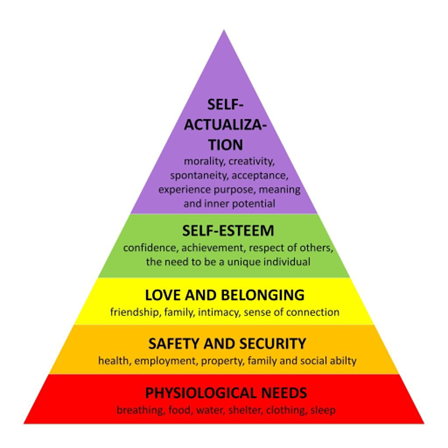Maslow's hierarchy of needs is a psychological theory that arranges human needs in a pyramid (see graphic below), with basic needs at the bottom and higher-order needs at the top. For HR professionals, understanding this hierarchy is crucial for employee motivation and satisfaction, as well as workers’ compensation claim outcomes.  A workplace injury can really tip this pyramid on end for an injured worker, depending on how their employer responds to the employee and their injury. By helping to ensure that the injured worker’s most basic needs can be met, they can then focus more on healing and work toward more favorable outcomes. If, however, the employee is more worried about where they will sleep tonight, or how they will feed their family – you can probably expect a less favorable outcome with their workers' compensation claim.
A workplace injury can really tip this pyramid on end for an injured worker, depending on how their employer responds to the employee and their injury. By helping to ensure that the injured worker’s most basic needs can be met, they can then focus more on healing and work toward more favorable outcomes. If, however, the employee is more worried about where they will sleep tonight, or how they will feed their family – you can probably expect a less favorable outcome with their workers' compensation claim.
With all of this in mind, here are my “Top 5 Tools in your Workers' Compensation Toolbox” – use them to ensure your program not only meets the needs of the injured worker but helps your organization achieve more positive outcomes.
- Empathy: Infuse empathy into your workers' compensation claim management program. Recognize the emotional toll an injury can take on an employee. Acknowledge their pain, fears, and concerns and help them navigate the claims process (as most people have never been through a WC claim before). A compassionate and empathetic approach sets the foundation for a smoother recovery journey and more favorable individual outcomes.
- Return to Work Program: A well-structured return to work program should follow an injury. It's not only about physical recovery but also about restoring a sense of purpose and normalcy. When possible, tailor return-to-work plans to individual needs, providing not only accommodations but also support. This will not only aid in a speedier recovery but also will strengthen the employee's connection to the workplace.
- Prevention: Implement proactive safety measures to prevent accidents. Regular safety training, hazard assessments, and a culture of safety awareness are essential in creating a workplace that prioritizes prevention over reaction.
- Policies & Procedures: Well-defined policies and procedures shield against uncertainties in workers' compensation claims. Establish transparent guidelines that outline the entire claims process and who is responsible for what. This fosters trust, clarity, and a sense of security among employees, ensuring everyone understands the steps involved.
- External Partners: Choose Partners Wisely! Don’t feel like you need to tackle everything on your own - collaborate with vendors and let them shine in what they do best while you focus on YOUR business. The best partners will share your commitment to employee well-being and engagement and offer solutions for the problems that keep you up at night. From insurance agents to healthcare providers, PPE vendors to rehabilitation services - a strong vendor network also ensures a comprehensive support system for the injured worker.
By aligning with Maslow's Hierarchy of Needs, you not only address the physical aspects of recovery but also nurture the emotional and psychological well-being of your employees, creating a workplace that thrives.

COMMENTS